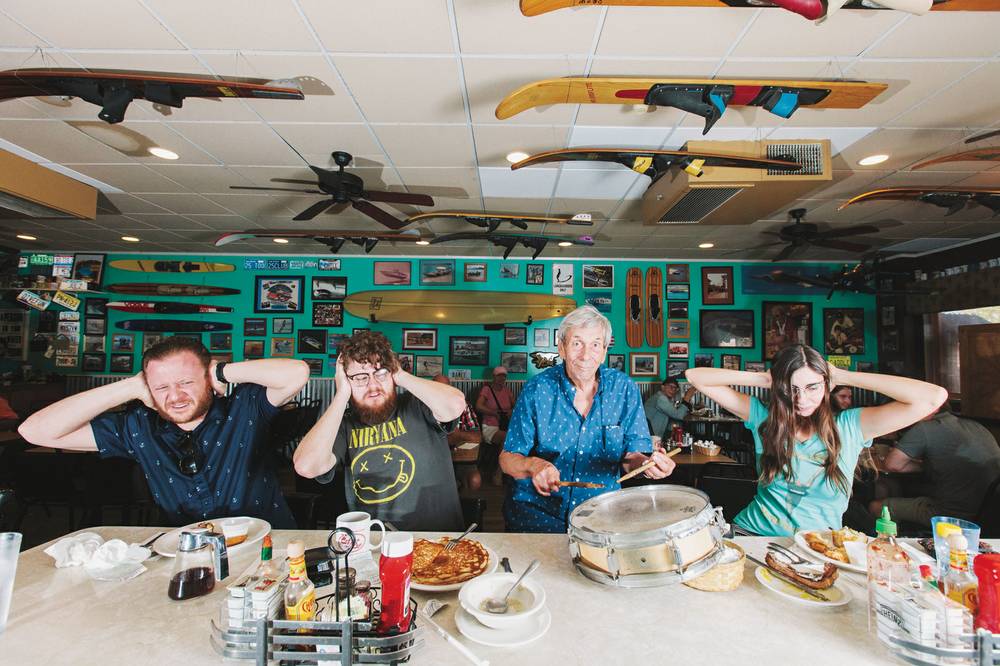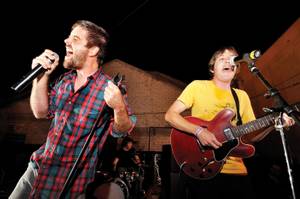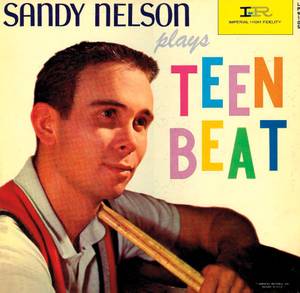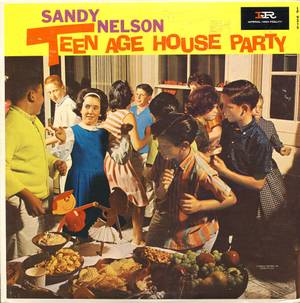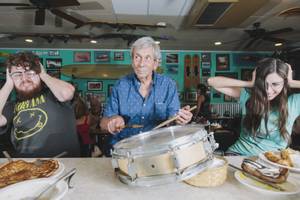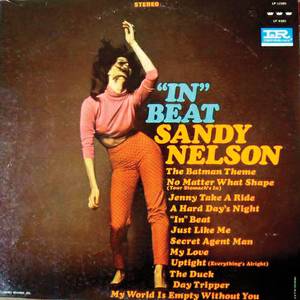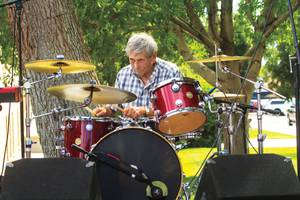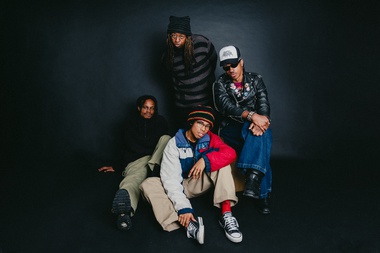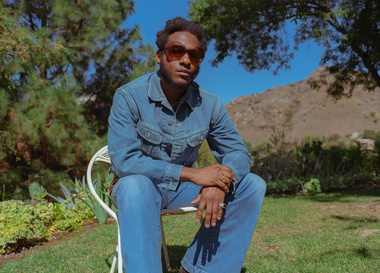It was 22 years ago when the idea for the Veebles came to Sandy Nelson. They weren’t shoot-you-with-a-stun-gun and beam-you-up type aliens. These cute extraterrestrials landed on Earth in search of something far more innocent.
“They’ve come to make Earthlings jump up in the air and tell dumb jokes,” the drummer, pianist and local celebrity explains. And they love music and food, “sort of like the Greeks and Romans.”
The Veebles were preserved but unheard by the world, captured on Nelson’s never-released recordings—pre-Pro Tools arrangements he wrote on a synthesizer, charmingly loaded with piano, strings, drums, horns and layered vocals, the latter sped up to sound something like the Great Gazoo’s offspring. No doubt, it’s the warm and fuzzy work of a musical genius.
*****
At 76, Sandy Nelson is one of Boulder City’s most eccentric characters—and while he can tell one hell of a story, he can still keep an even meaner beat. The drummer’s bombastic rhythms helped define surf rock in the late ’50s and early ’60s, when he worked as a session drummer and a solo artist, his thumping, wild beats influencing the artists you’ll find in every tiki-lounge jukebox (he’s in the one at Frankie’s). For years, he’s been an approachable star in the sleepy town to the south—a man who collects smiles and shares memories like trading cards.
Nelson was drawn to Nevada as a little boy, when “all there was was Glitter Gulch,” and not even a shell of the Strip. “The swamp cooler just turned me on,” he recalls of his aunt and uncle’s trailer in the desert, “the sound of it and that wooshing air, and my mother and aunt making percolated coffee at 3 in the morning.” He moved to Boulder City in 1988 and has lived there since, keeping busy building an underground cave in his backyard, his “attractive nuisance.”
Most mornings are spent at the Coffee Cup diner, where everyone knows Nelson’s name. He orders his usual: a cup of oatmeal, one egg over-medium, a slice of toast and half a cup of coffee. Cozied up to the bar, he talks to a waitress about astronomy (his “higher power”) and soul waves and the supernatural, stops for photo ops and reminisces about the days when he hung with Phil Spector and Bruce Johnston. “I have to drop his name ’cause he’s with The Beach Boys,” Nelson boasts charmingly of Johnston. There’s also the time Juliet Prowse danced to his song “Bouncy” on The Ed Sullivan Show.
He’s in a checkered blue button-up, his shirt pocket full of odds and ends: pieces of paper he scribbles notes on, business cards and a plastic, makeshift cigarette holder that’s been taped together, cradling two thin brown Mores. At his side rests a worn but colorful butterfly cane. His salty-white hair frames a gentle face, weathered but warm, with the same grin from the covers of his old albums.
“Anyone that’s familiar with rock ’n’ roll should be quite aware of Sandy Nelson’s presence,” says Burger Records co-founder Lee Rickard, who plans to release Nelson’s five-song concept album The Veebles on the label. “In the early ’60s, he played on [Rock and Roll Hall of Famer] Gene Vincent records, he did drum overdubs on The Teddy Bears. ... Anyone that’s into digging for records, they’ll surely come across his records, ’cause he’s made more records than most people. They’re all really great and a lot of fun to listen to. He’s a legend.”
*****
At the piano inside the Boulder Dam Hotel lobby, Nelson tickles the ivories for guests. They probably don’t know they’re in the presence of musical royalty—Mr. Sandy Nelson, creator of singles like “Civilization.”
“I used to make a lot of tracks I’m very proud of,” Nelson says, referring to that one in particular. “I put a microphone [outside], and there was a cricket out there—‘Brrrp! Brrrp,’” he says, imitating the sound he captured. It led him to overdub traffic sounds from outside his house, and add the sound of water pouring from a hose into his pool, back before experimental music even had a name. He toured with The Ventures and recorded with Kim Fowley and the Hollywood Argyles, to name a few. For seven years he ran his own pirate radio station, KPOOP 1590, until it was shut down by the FCC.
His best-known single, the instrumental “Teen Beat,” was released in 1959 and reached No. 4 on Billboard’s singles chart. It was a rare time when drum instrumentals could actually climb the charts alongside giants like Elvis and Frankie Avalon, but even then it was uncommon.
That hit was followed by Nelson’s “Let There Be Drums,” which reached No. 7 in 1961, both songs preceding classics like The Surfaris’ “Wipe Out” or The Beach Boys’ “Surfin’ USA.”
“Him making those hits definitely paved the way for music like ‘Wipe Out,’” says local singer and guitarist James Adams of Same Sex Mary. “You grow up listening to your parents’ music, and he knows all of them.”
Nelson’s fascination with drums began in that vein, when his parents “had these drunken parties. The music they’d play, some of it really grabbed me. I’d look down the hallway with my pajamas on and see Aunt Sylvia dance. After the party I’d sneak in and take some of the records to my own little phonograph”—songs like “Rose Room” and “Song of India.” “I was just fascinated.”
He saw legendary drummer Gene Krupa play in Downtown LA, and by age 8 was learning on his first drum kit, an old set from the ’20s. A fan of big band and swing, Nelson’s tastes began to change in his teenage years, as he listened to Little Richard, Ritchie Valens and Fats Domino. Over time, he taught himself by watching idols like Little Richard’s drummer Earl Palmer, the kind of musician he never imagined he’d get to meet.
*****
The key for Nelson was landing a job in the backing band for KPOP disc jockey Art LeBoe with Johnston, Dave Shostak and Kip Tyler. With his foot in Hollywood’s door, he started playing as a session drummer, filling in for doo-wop groups and finally securing his own cheap recording sessions. And he toured the country. During a gig in Hemet, California, he played in a band with a teenage Phil Spector on guitar.
“[Spector] was obnoxious,” Nelson says. “We drove my old ’49 Chevy down to Hemet to do the gig, and all he could say about the farms in his New York accent—he sounded like Sylvester the Cat—he’d go, ‘What do people do out here? There’s nothing out here!’”
Through that relationship, though, Nelson became the session drummer on The Teddy Bears’ single “To Know Him Is to Love Him.” And not long after, he’d find inspiration for “Teen Beat” inside an LA burlesque club.
“We’d all meet and go in the strip [club], and while they were looking at these pretty girls in G-strings, guess what I was doing? I was looking at the drummer in the orchestra pit,” Nelson laughs. “The drums looked real dirty, but he was doing kind of a [jazz standard] ‘Caravan’ beat—‘Bum ta da da dum’—small toms, big toms. That’s what gave me the idea for ‘Teen Beat.’”
Nelson took the track to LeBoe, hoping he’d distribute it on his label, Original Sound Records. At a time when payola was still unethical, LeBoe gave it a spin on his radio show first, to test the waters. “Not only that,” Nelson says, “the little rascal, he played the actual acetate from the lathe, and he wasn’t going to press it up unless he got a few calls.” LeBoe played it on the show and got three calls, so he pressed the single. It would be the label’s biggest hit.
*****
In 1963, Nelson was living the high life. He’d signed to Imperial Records and had two charting singles, with money rolling in. He’d drive to Santa Monica on his motorcycle every week to visit his fiancée. And then a violent accident changed his life forever.
A school bus came around the corner, “the sharpest curve in Mulholland Drive,” and Nelson grazed it with his elbow, thinking he’d escaped ill fate. “I thought, ‘I hope I have some Band-Aids at home.’ Not realizing that a split second [later] my right foot [would get] caught in the wheel of the bus.”
Nelson’s leg was mangled in the crash, and he spent the next six weeks in the hospital. His right leg was removed due to gangrene.
In two months, Nelson’s life had been turned upside down (he and his fiancée never wed), and there were times he felt like giving up—like when he got fitted for his prosthetic. His new leg was uncomfortable and the process painful. But a young boy in the same room gave him hope. “He lost both legs playing in the railroad yards. He had two of those test legs on, and he was on the parallel bars with a big smile,” Nelson says, holding back tears.
He’d continue to play the drums and release records, positioning his hi-hat on the right so he could play with his prosthetic. And he developed an even better technique on the bass drum. “I never thought of just stopping,” Nelson says. “I always ended up playing in some situation.”
*****
Today, it’s a pretty quiet life. Nelson has battled with alcohol and depression (he’s been sober since 1976), but his off-kilter humor and youthful wanderlust keep his stories upbeat and entertaining. He’s someone you can talk to for hours.
“My whole drumming career has gone to playing for pig roasts and hot-dog-eating contests,” he jokes, referencing Boulder City’s annual bratwurst festival, Wurstfest, at which he played on September 26. The same man who worked often with René Hall, the guitarist on Ritchie Valens’ huge hit, “La Bamba.” As Rickard says, “He’s just been around.” But Nelson is content to still be making noise. And records. The Veebles’ friendly alien colony was forged 22 years ago inside his Boulder City motorhome, and soon, the wondrous creatures will be unleashed on the world.
“I just jumped at the opportunity to work with Sandy,” Rickard says, as Burger Records gears up to release The Veebles on cassette. “Sandy Nelson is rock ’n’ roll to the bone, and we’re happy to be working with him in any capacity. There’s not too many first-wavers still among us. It’s our job to find them and give them the respect they deserve.” Rickard is just waiting on the masters, and Nelson’s old pal Dean Ormsby Torrence, of early surf duo Jan and Dean, who’s slated to do the album artwork. “I really hope to introduce Sandy to a new audience,” Rickard says.
Nelson’s path has always cut like that—positive moments striking just at the right time. Not only is he full of those stories, he’s happy to share them, everything from music to love and loss.
We go outside for a cigarette, and I ask if he believes in fate. Most of his stories have that connective tissue, a certain cosmic something stringing them together.
“I’m beginning to come around,” Nelson says, “acknowledging that things happen for a purpose.”
After a few puffs, he puts the embers out with his fingers. “You just never know what’s going to come out of left field.”
DRUMS & STORIES WITH SANDY NELSON October 23, 7 p.m., Forge Social House, Boulder City, 702-293-6743.
